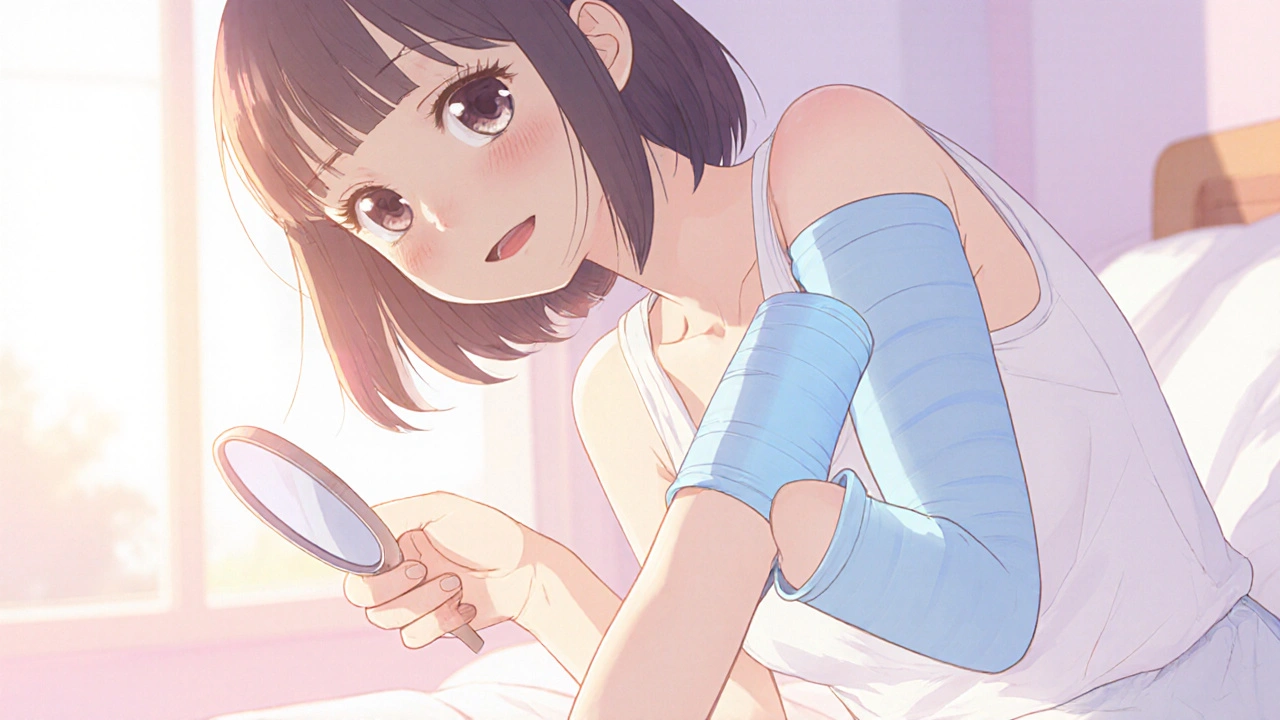Lymphedema Compression Garment Selector
Lymphedema Compression Guide
Select your limb measurement points (10cm above and below elbow for arms, 10cm above and below knee for legs). This tool helps determine the appropriate compression class based on medical guidelines.
Recommended Compression Class
Class 1
15-20 mmHg
Best for:
- Early-stage lymphedema
- Prevention after surgery
- Light daily activities
Class 2
20-30 mmHg
Best for:
- Moderate swelling
- Most adult cases
- Primary daily management
Class 3
30-40 mmHg
Best for:
- Severe lymphedema
- Refractory swelling
- Advanced fibrosis
When cancer treatment leaves a limb feeling heavy and tight, it’s often a sign of Lymphedema is a chronic swelling caused by lymph fluid buildup, typically after surgery or radiation that disrupts the lymphatic system. For cancer patients, managing this swelling isn’t just about comfort - it directly impacts mobility, infection risk, and quality of life. Below you’ll find a step‑by‑step roadmap to keep the fluid in check, protect the skin, and stay active throughout recovery.
Key Takeaways
- Early detection and gentle compression can halt progression in most cases.
- Combine compression garments with targeted exercises for the best volume reduction.
- Daily skin care and moisturising prevent infections that can worsen swelling.
- Pneumatic compression devices are useful for stubborn limb volume but need a prescription.
- Regular monitoring with a lymphedema therapist ensures adjustments stay effective.
Understanding Lymphedema in Cancer Care
Most people associate lymphedema with breast‑cancer surgery, but any cancer treatment that removes or damages lymph nodes - such as pelvic, melanoma, or head‑and‑neck surgeries - can trigger it. The lymphatic system’s job is to drain interstitial fluid; when pathways are blocked, fluid accumulates, swelling appears, and the tissue becomes fibrotic over time.
Risk Factors and Triggers
- Extent of node removal: More than 10 lymph nodes increase risk dramatically.
- Radiation therapy: Fibrosis of vessels impairs drainage.
- Infection or injury: Cuts, cellulitis, or even tight clothing can exacerbate swelling.
- Weight gain: Extra adipose tissue puts pressure on remaining lymph channels.
- Sedentary lifestyle: Lack of muscle pump activity slows fluid return.

Assessment and Staging
Lymphedema is usually graded from Stage 0 (subclinical) to Stage III (severe, with skin changes). A qualified therapist measures limb circumference at several points, compares it to the unaffected side, and may use bio‑impedance spectroscopy for precise fluid quantification. Staging guides the intensity of the treatment plan.
Core Management Strategies
Effective control blends several approaches. Think of them as layers of a protective system - each adds stability.
1. Compression Therapy
Compression garments apply gentle, graduated pressure higher at the distal end and lower proximally, encouraging fluid to move upward. They come in short‑sleeve, full‑arm, thigh‑high, or custom‑fit styles. For most patients, a class2 garment (20‑30mmHg) is the sweet spot - firm enough to move fluid but comfortable for daily wear.
2. Exercise and Activity
Dynamic exercises - shoulder rolls for arm lymphedema, ankle pumps for leg - activate skeletal muscle pumps. Aim for 30 minutes of low‑impact activity (walking, swimming, yoga) most days, followed by a short compression session.
3. Skin and Wound Care
Stretched skin cracks easily. Clean the limb daily with mild soap, pat dry, and apply a fragrance‑free moisturizer. Any break should be covered with a sterile dressing and reported to a clinician immediately.
4. Manual Lymphatic Drainage (MLD)
MLD is a light‑touch massage performed by a certified therapist. The strokes follow lymphatic pathways, nudging fluid toward healthy nodes. Sessions are usually 45minutes, 2-3 times a week during the initial phase.
5. Pneumatic Compression Devices (PCDs)
PCDs consist of an inflatable sleeve that cycles pressure from low to high, mimicking the muscle pump. They are ideal for patients who struggle with garment compliance or have persistent swelling despite other measures. Prescription, training, and regular cleaning are mandatory.
6. Dietary and Lifestyle Adjustments
- Maintain a balanced diet rich in lean protein to support tissue repair.
- Limit sodium to under 2,300mg per day to reduce fluid retention.
- Avoid alcohol excess, which can impair liver function and fluid balance.
7. Surgical Options
When conservative therapy stalls, surgeons may offer lymphatic‑oven anastomosis, vascularized lymph node transfer, or debulking procedures. These are performed in specialised centres and require a multidisciplinary evaluation.
Choosing the Right Compression Garment
Not all garments are created equal. Below is a quick comparison of the most common options.
| Option | Typical Pressure (mmHg) | Best For | Pros | Cons |
|---|---|---|---|---|
| Class1 Sleeve | 15‑20 | Early‑stage, light activity | Comfortable, inexpensive | Limited fluid shift |
| Class2 Custom‑Fit | 20‑30 | Most adult arm/leg cases | Strong compression, good durability | Higher cost, needs fitting |
| Class3 Power‑Fit | 30‑40 | Severe or refractory swelling | Maximum fluid reduction | Can be uncomfortable, risk of skin irritation |
| Pneumatic Sleeve | 10‑50 (adjustable) | Home use, adjunct to garments | Dynamic pressure, can be timed | Requires power source, maintenance |
Start with a class2 custom‑fit garment, monitor limb volume weekly, and adjust pressure as needed. If swelling plateaus, discuss adding a pneumatic device with your therapist.

Monitoring Progress and When to Seek Help
Track circumference at three standardized points (e.g., 10cm above and below the elbow for arm lymphedema) every Monday and Thursday. A reduction of 1cm over two weeks signals that the plan is working. If you notice:
- Rapid volume increase (>2cm in a week)
- Redness, warmth, or fever - signs of cellulitis
- Painful tightness that doesn’t ease with compression
Contact your oncology nurse or lymphedema therapist promptly. Early antibiotics can prevent serious infection.
Common Pitfalls and Practical Tips
- Skipping daily wear: Even a few hours off the garment can let fluid rebound.
- Wearing too tight: Discomfort often means pressure is excessive, risking skin breakdown.
- Neglecting arm/leg elevation: Elevate for 15 minutes after exercise to boost drainage.
- Using harsh soaps: They strip natural oils, making skin more vulnerable.
- Ignoring weight changes: Even modest gain can overload the lymphatics.
Think of your lymphedema routine like a daily medication - consistency beats intensity.
Frequently Asked Questions
Can lymphedema be cured?
There is no permanent cure, but effective lymphedema management can keep the swelling stable or even reduce it. Many patients live symptom‑free for years with proper care.
How soon after surgery should I start compression?
Ideally within the first week, once the incision has healed enough to tolerate gentle pressure. Early use dramatically lowers the risk of chronic swelling.
Is pneumatic compression safe for home use?
Yes, if prescribed by a therapist. Follow the device’s cleaning schedule, use the recommended pressure range, and limit sessions to 30‑45minutes.
What foods help reduce swelling?
High‑protein foods (lean meat, legumes), plenty of fresh vegetables, and low‑sodium fruits (berries, apples). Stay well‑hydrated; water supports lymph flow.
When should I consider surgical options?
If stageIII swelling persists after 6‑12months of intensive conservative therapy, or if recurrent cellulitis threatens limb health, a referral to a microsurgical centre is appropriate.
Managing lymphedema is a partnership between you, your oncology team, and a certified therapist. Stay proactive, keep notes, and adjust the plan as your body changes. With the right tools, swelling can become a manageable part of life rather than a constant obstacle.







Tom Green
October 17, 2025Hey folks, early detection of lymphedema can really change the game – catching the swelling before it gets firm makes compression work much easier. Keep an eye on any tightness or heaviness after surgery, and start a gentle class‑2 sleeve as soon as the incision is healed. Pair that with simple shoulder rolls or ankle pumps a few times a day; the muscle pump is your best friend. Also, don’t forget to moisturise the skin daily – a well‑kept barrier fights off cellulitis. If you track circumference twice a week, you’ll see trends and can tweak the plan before things spiral.